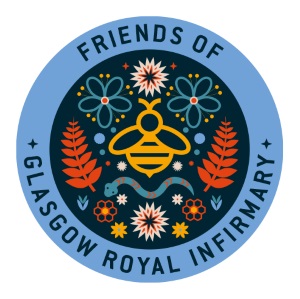Personal Stories
Student Memories of 1939 - from peace to war
Student Memories of 1939 - from peace to war
Professor Norman Grist (1918-2010)
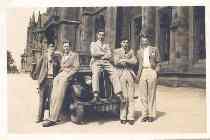 Professor Grist graduated in 1939 BSc; 1942 MBChB. He visited Europe as a student in 1939 with three other students to experience Europe in the final moments before war changed everything.
Professor Grist graduated in 1939 BSc; 1942 MBChB. He visited Europe as a student in 1939 with three other students to experience Europe in the final moments before war changed everything.
Student Memories
Student Memories of 1939 - from Peace to War
Several medical students in the 3rd year of the “Science-Medical” course at Glasgow University intended next year to complete the BSc Hons. with three more years for medical qualification. I lived at home, travelling from Shawlands daily to the university by train & tram. Other active interests included the piano (both classical & jazz), also tennis and University Union dances that provided fun encounters with the opposite sex. Golf was only an occasional interest, practised mainly with school-friends Sandy & Archie. I also explored the Scottish countryside and hills on foot and by bicycle, whenever possible using Youth Hostels, & introduced to the Cairngorm country by Sandy.
World politics concerned us students as we discussed problems & prospects, idealistically setting the world to rights in lunch-time summer sun on the grassy bank in front of the university - while biplanes from Renfrew Flying Club and the University Air Corps droned overhead. Emotions were mixed & sceptical on the closing night in 1938 of the Empire Exhibition in Bellahouston Park, where with friends I had danced the Eightsome Reel in pouring rain after the Munich agreement was announced.
Three of us students planned a tour into Europe to see things for ourselves in summer ’39. As tourists, members of the Scottish Youth Hostels Association & International Confederation of Students, we enjoyed various discounts.My total expenses for 5 weeks abroad were only £20 - not counting passport - for the rare experience of Europe in the final moments before war changed everything.
From Peace
Our party numbered four: Gordon & Maurice with Tommy, his cousin, & myself.. Our inexpensive start was overnight to London in the back of a furniture van for 5 shillings. After a night at my aunt’s flat (she was away), we booked round tickets by SNCF, crossed from Dover & reached Paris on ‘Le quatrieme Juillet’. We installed ourselves in the Collège Franco Britannique of the Cité Universitaire and went out to see the celebrations. The Place de la Concorde was crowded but less exciting than we expected. For days we wandered the boulevards, lingered in cafes & visited the Pasteur Institute & other well-known sights. Sadly we did not see the glorious windows of Ste.Chapelle which were already removed for safe storage against bomb damage. Contact with fellow-students from many nations plus the atmosphere & glories of Paris made a lasting impression. We failed to get into the Folies Bergére but experienced the flamboyantries of the Casino de Paris, escaped Montmartre without entanglements & looked forward to our return visit.
Next morning we took a rattly Renault taxi to the Gâre de Lyon. Being late, we asked to go fast - the driver more than complied, screeching round corners on cobbles & rewarded with our remaining coinage! We got our breath back in the train to Dijon which we explored, had a jolly evening with medicals at the local hospital, relished the mustard, & heard the town band next morning on our way to the station. We continued past the Juras by train & enjoyed a picnic lunch of French bread, butter, cheese, fruit and beer which became a regular feature of our rail travels.
At Geneva we stayed at the Hôtel Internationale des Étudiants, where we again found many congenial young folk from many countries. Maurice & Gordon spoke good French, Maurice (the eldest) also knew Italian. I had a smattering of French, Gordon & I had a very little German, & Tommy, the youngest, had none of these. Next day provided my first sight of the wonderful El Greco paintings evacuated to Geneva from the Madrid Prado Museum for protection during the Spanish Civil War.
A night out with a jolly group of 2 Germans, an American girl, a Turk and a Romanian provided fun: we were arrested on the technicality of driving noisily along the water front in/on an open DKW car licensed for only four persons. At the Police station suddenly none of us could speak or understand French (the only language of our captors). We signed in and were let out with the option of a 5 shilling fine each or a court appearance. Within 2 days we were approached by two British international lawyers who heard some lads from Scotland were in trouble & offered to defend us free of charge as relaxation from their dull high-level affairs! We declined with thanks & paid up so as not to be delayed. Being warm but critical admirers of the League of Nations, we visited the Palais des Nations. We toured the sights of Geneva, enjoyed the plage and the company of the American, some Dutch and Swiss girls. We continued our travels by train to Lausanne to lunch at the university; then on to Montreaux on the 20th where two Danish girl students joined us for dancing and the walk to Vevey, by boat to Evian and on foot to Thonon. At the hostel there for the first time I took the 3-course meal entirely served & consumed from a single bowl and set of implements (one certainly cleaned one’s platter!).
Monday 24th brought us to St.Gervais les Bains where we left our bulkier baggage ( flannels etc.) to walk next day up the Col de Bonhomme, across the summit (2900m = 9518ft) through mist and snow for a night at Les Mottets chalet. There & along the way we appreciated the rough, refreshing vin ordinaire, & café au lait quaffed from generous bowls (where are they now?). Our simple hill-walking equipment was heavy shoes & stockings, shirt & jersey, blazer, cape, & sun glasses! Next day we strolled to the nearby glacier, and after overnight rest crossed the Col de la Seigne. At the frontier we chatted to the friendly French “Diables bleu”( Chasseurs Alpines) & were held up by the Italian frontier guards (Alpini) to stamp our passports & seal our cameras before we passed the military camp of soldiers. (From here some months Mussolini later inflicted the “stab in the back” on embattled France). But all then was friendly, and we enjoyed a relaxed evening at the busy little village (then!) of Courmayeur, with a simple good dinner, a crowded night (4 of us in 2 cots), and on to Aosta next day to rejoin Maurice & Tommy who had moved independently. Gordon & I still remembered enough school Latin to try this with an assumed accent from France - and it worked! Also here I first tasted real Neapolitan ice cream - much superior to that so-named sold in Glasgow.
Maurice, the fussy one, eventually decided our lodging for the night, and after dinner and a cinema we slept well. Next day we strolled around historic Aosta & took a bus to picturesque old St Remy, a sleepy country village on our north-bound route. Next morning a bus crowded with locals, baskets & poultry carried us up the mountain valley across the St. Bernard pass back to Switzerland. We walked to Vallorcines for meal & bed whence “travellers’ diarrhoea” afflicted us next day. So we strolled gently into Chamonix, where welcome though watery tea in a hotel restored us (the only tea taken during our trip). We returned next day to St. Gervais, rejoined our baggage, and rested for two days, visiting the casino twice (no wins, insignificant losses). We continued by train to picturesque old Annecy where I photographed washerwomen pummelling laundry on a platform in the running river; then on by train to Aix les Bains (lunch), Chambery (coffee) & spacious Grenoble where we enjoyed the luxury of a hotel, dinner, and a confusing stroll - the square blocks of the city appeared to have 5 sides, not 4 (was dinner too much?).
At a cinema we enjoyed a film & ice cream, & improved our tourist knowledge of the attractive city next day by teleferique and a good lunch before re-embarking to Lyon for more sight-seeing , another fine meal, cinema & ice creams. This busy city had an impressive character, with noble buildings and cathedral, but we left for industrial Nevers for dinner & a game of chess before bed. August 4th brought us back to Paris, lunching on the train. We revisited Montmartre, Sacré Coeur & found modest lodgings where the rickety w.c. collapsed & lacerated Tommy who required & got a local doctor’s attention. We explored the Bois de Boulogne next morning, the Zoo (unimpressive) and that evening the Opera - a dull, static “Valkyries”, in French translation. Next day we continued sight-seeing rambles, café visits in Montmartre, and enjoyed a siesta in the Luxembourg gardens after lunch on Friday. At dinner in Montparnasse we failed to get frogs’ legs but celebrated this last night in France with champagne.
On August 12th Maurice had left to visit friends near Bordeaux (almost caught by the outbreak of war, he escaped in a small boat across the Channel). Tommy, Gordon & I took the train to Dieppe & Newhaven (later my port of departure to France for the “D-Day” Normandy landings). After another night in my aunt’s flat we lunched in Soho & visited the British Museum. Tommy caught a hitch-hike in luxury in a Rolls Royce back to Glasgow. Gordon & I continued our tourist visit to the London area and returned to Glasgow by overnight bus arriving at 4.30 pm on Tuesday 15th - and so home by tramcar, thrilled by our international experience, warmed & comforted by the friendliness of our encounters - Germans included. Surely there would be no war?.
To War
Next day Gordon & I met at the university, paid examination fees & picked up our social, private & student lives again. Hitler invaded Poland on September 1st. Next morning I reported to nearby Pollokshaws Baths as a medical student volunteer to the newly forming First Aid Post in its basement. In sunshine outside the Baths I listened to a portable radio as Chamberlain spoke and declared war. From then on I did my best to help in 12 hour night shifts (later 8 hours), taking part and sometimes providing (more often receiving) training lectures and demonstrations on first aid and related topics - feeling a bit out of touch without as yet significant clinical experience. On the radio while on duty I heard that the Athenia had been torpedoed - the first & only liner on which I had stepped aboard while docked for a few days at the Broomielaw, Glasgow. In the event, for months of this locally quiet “phoney war” we had no bombing or other casualties (we rehearsed with a mock air raid on Sept.17th). Nevertheless I stopped my piano lessons as perhaps frivolous in war (wrong!) & studied for BSc final examinations on night shifts : I duly passed.
We Science-Medicals sought advice from the Dean on what best to do - volunteer for armed service or what? We were advised to forget our intended 4th Honours year and continue straight into 3rd year medical studies to qualify as useful as soon as possible - this we did. Mainly undisturbed nights at the Baths allowed sleep, & I walked home at 6 am in fresh morning air for breakfast and then by local train into town and on to the university by tram or on foot, struggling to stay awake before lunch break. Simple fare (pie & chips, at the Union, or “Scotch egg”, plus Swiss Tart or “Scotch Trifle” as occasional luxuries at Hubbard’s or other cafes) saw us on our way to afternoon classes. Often Gordon & I walked across town to the Royal Infirmary, admiring Glasgow’s Victorian buildings and such novelties as the window display of the Anarchists’ Association below the City Chambers. Our shoes were filthied by the grime of industrial Glasgow - a black soup in the usual wet west coast weather. Yet in those days a mild breeze from the west would bring the scent of bog myrtle into the city, and wild meadows in nearby countryside were a riot of meadow-sweet and other flowers in season.
My mother buckled down to make the best of rationed foodstuffs & kept my father & me well nourished with the help of potatoes, lettuces etc. from the garden. I was disappointed to find that young garden peas were not the same as the delicious petits pois of France! By November I was back into the routine of studies, clinics, society meetings, occasional dances. I graduated Bsc & attended the First Aid Post as required (many fellow students did fire-watch duties at the university or hospitals). My father, like many others, became a part-time air raid warden at his office. Our air-raid “shelter” at home was “under the stairs” of our solid, stone-built house, but not yet used as such. Radio (“Wireless”) was a valued source of entertainment, news & comment. In addition to the trusty BBC, I had long been accustomed to foreign stations, and found the Swedish news bulletins an interesting extra source of information. Photography was an active interest as I exploited the capabilities of my SLR Robot camera. Being German, its special film cassettes were no longer available, but I practiced cutting & loading scrap lengths of 36 mm cine film in darkness successfully..
My diary records little of note as the year ended. Christmas day at home would be traditional, and parties at the First Aid Post for Christmas & Hogmanay ended the prelude to next year’s serious war & studies.
Footnote
Tommy sadly died a few years later.
The others qualified and served in the Navy, or, for myself the R.A.M.C..
In subsequent careers two of us became professors at Glasgow University & Fellows of this College (RCPSG): Gordon T. Stewart (Public Health) and myself (Infectious Diseases).
Wartime experiences influenced later research activities of Gordon (bacteriology, penicillin) and Maurice Thomson (heat stress, dyshydrosis & UV exposure: Reader in Applied Physiology, University of London; & Assistant Professor of Preventive Medicine, University of Cincinnati) who died in 1981 aged 73
24.12.02
He joined the Army RAMC from 1943 to 1946. An account of D-Day landing can be found in RCPSG Archives.
Following the War, he became interested in research into infectious diseases. He was an assistant in the new University department of Infectious Diseases. He was part of the virology initiative in creating the first Virus Laboratory. He was a lecturer at Ruchill hospital and was later a founder member of the first University Virology Department with Professor MGP Stoker in 1962. He became reader in Viral Epidemiology and later succeeded Professor T Anderson to the Chair of Infectious Diseases in 1965. He retired in 1983.
He developed diagnostic/epidemiological services in Respiratory, Smallpox, Poliomyelitis etc. He was regional adviser and member of an expert panel for Virus Diseases for the World Health Organisation. He had wide ranging international experience and was a frequent rapporteur with many publications during his career.
Post retirement, he was interested in Natural History and was president of the Glasgow Natural History Society from 1993 - 1996.
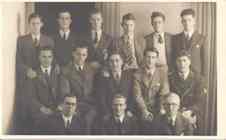 Further reading can be found in the following articles by Professor Grist.
Further reading can be found in the following articles by Professor Grist.
-
Student Memories of 1939 - from Peace to War. Bulletin of the Royal College of Physicians and Surgeons of Glasgow 2003;32/1: 12-15
-
Bird Flu - A Flying Start to Virology in Glasgow. Bulletin of the Royal College of Physicians and Surgeons of Glasgow 2003;34/3: 9 - 13
-
When Aliens Meet: European Rabbits and American Viruses in Australia and in the World. The Glasgow Naturalist 2001 Vol. 23 Suppl., 23 - 25
Photographs courtesy of Professor Grist. Students at Gilmorehill and the Science Medical Men.
A temporary job in General Practice from 1949 to 1988
A temporary job in General Practice from 1949 to 1988
Dr JK Chisolm
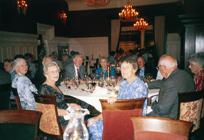
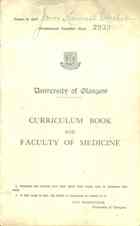 A student during World War II and Faculty of Medicine graduate in 1945, part of a happy bunch of students who enjoyed spontaneous sing songs in the classroom! Click on the link below to read more.
A student during World War II and Faculty of Medicine graduate in 1945, part of a happy bunch of students who enjoyed spontaneous sing songs in the classroom! Click on the link below to read more.
Developer of early apparatus for the operating theatre
Developer of early apparatus for the operating theatre
Dr AK Boyle
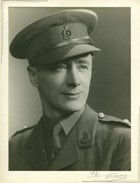 Dr AK Boyle's son discussed his father with the curator of the Hunterian Museum.
Dr AK Boyle's son discussed his father with the curator of the Hunterian Museum.
"It was nice to chat to you earlier today about your forthcoming display at the Hunterian Museum. As promised, I have attached a photograph of my late father, Dr. A. K. Boyle.
His obituary, mentioning his development of an early apparatus for the control of hypothermia in the operating theatre, can be found in the BMJ of December 24th 1966.
The development of this apparatus was reported - together with a photograph - in the Glasgow press in the mid to late 1950's but, despite a search through the microfiche records at the Mitchell Library, I have been unable to trace the article (from memory it was in The Glasgow Herald - but may have been The Bulletin, Citizen or Times).
Photograph of Dr Boyle from his son
Village life
Village life
Dr Gail Addis
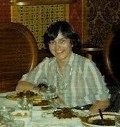 MBChB MRCGP DCH DROG DFFP A graduate in 1979 who worked in Paediatrics, General Medicine, Respiratory Medicine and Geriatrics and now works in General Practice. She recalls changing fashions and tastes as a student and how your dad can be always be guaranteed to cause you embarrassment, whatever your age. Click on the link below..
MBChB MRCGP DCH DROG DFFP A graduate in 1979 who worked in Paediatrics, General Medicine, Respiratory Medicine and Geriatrics and now works in General Practice. She recalls changing fashions and tastes as a student and how your dad can be always be guaranteed to cause you embarrassment, whatever your age. Click on the link below..
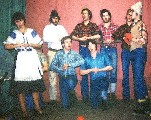 Photographs courtesy of Dr Addis
Photographs courtesy of Dr Addis
A female resident in the 1940s
A female resident in the 1940s
This graduate of 1949 enjoyed her course very much. Highlights included watching a handsome doctor perform emergency operations, dressing up for the Medico - Chirurgical Ball and student charities day. Though thought to be difficult to get a residency at the Western Infirmary, it did mean your own suite of rooms. A varied career followed and a very busy retirement.
Some recollections
Graduation
After sixth year at school, as I was not seventeen I spent a year in the Faculty of Arts and then went into the Medical Faculty graduating in 1949.
Interest in studying medicine
I don’t know exactly but I decided when I was about six years of age and stuck to it. As I got older I realised that making people better when they were ill was what I wanted to do. Listening to their story and investigating them became part of it. Later on I discovered that my extended family contained several doctors, the earliest being my grandmother’s two brothers, the first graduating in Aberdeen in 1866. My own father was a civil engineer.
Student memories and highlights
Yes. I enjoyed the course as a whole though the best time was from third year onwards when the work was mostly clinical. Most of the girls were very keen from the start though initially all the basic sciences might have put some off a bit. However in first year a few of us had the cheek to go to receiving nights at the Western Infirmary and went into the small gallery in the operating theatre to watch some of the emergency operations. I recall that Drew Kay (now Prof Sir Andrew Watt Kay), who was very handsome, even talked to us!
One of the highlights of the medical year was the Medico-Chirurgical Ball. It was attended not only by the medical students but by senior medical staff. Of course there was also the annual Charities Day when on a cold January Saturday we dressed up and persuaded the public to part with money to support the Voluntary Hospitals i.e. the Western, the Royal and the Victoria. We were always received with a smile from those we accosted for money – that was when the hospitals depended on donations from the public before the NHS.
Female to male ratio
There were 42 women to start with and about 140 men. I believe that now the ratio has changed and over 50% are women.
The course in 1940s
In the early years I preferred anatomy to physiology and felt I was getting somewhere with dissections. The best lecturers were the clinical teachers. In my time the clinical teaching in the wards was well organised. We were taught in small groups round the bed of a particular patient who agreed to this. They did not seem to mind – even falling asleep while we were talking! The course was structured to cover a lot of ground round the various groupings e.g. respiratory disease, cardiovascular problems and so on. The medical staff on the unit also gave their students lectures on various topics. I think now it would be called didactic teaching but it gave us a foundation on which to build. However I expect there are many changes now but we enjoyed very much what we had.
Career since graduation
The Western
I started with three resident house jobs each lasting six months. They were in medicine, surgery and obstetrics and gynaecology. Now it would be Foundation year 1 and 2. The first one was in the Professorial unit in the Western Infirmary. When we were in final year someone asked me where I was going to work and I said that as I had done all my clinical medicine in the Western, I thought I would go there. The response was ‘That’ll be difficult’. Well that was the first I knew that there was a problem. You would have thought I would have noticed that the absence of women residents but somehow I did not. However acting on that spur I went to see Professor McNee (later Sir John McNee) and asked him if he would consider me. Although I had never been in his wards as a student because I had certificates and prizes in clinical medicine and the medal in Practice of Medicine, he agreed. A further problem was that I could not go to the residency but I was given a little suite of rooms beside the wards and that was fine. I believe these rooms are used as offices now and of course there are no longer residents. I was the only woman resident at that time. I had a co-resident and normally he would have had 3 months in the little flat but of course as I could not go to the residency, he did not get his turn.
In my six months there I never had day off! I did ask for a few days off but was refused – I was rather annoyed but it didn’t seem to do me any harm.
The Royal Alexandria (Paisley)
Mr. A.B. Kerr who was a surgical sub – chief at the Western asked me to come and be his house surgeon in the Royal Alexandra Infirmary, Paisley (now R.A. Hospital). That was very nice of him, and I enjoyed my time there very much. The first thing he did was to tell me that he had heard how I was treated with regard to holidays and to fix up right away to have some time off. The experience there was splendid. Mr. Kerr had two wards and one resident. Emergencies were received on alternate days and on the other the theatre work was on ‘cold’ cases brought in from his list. The juniors performed small operations and assisted at emergencies. We also gave anaesthetics for the emergencies and small ops. In addition to the ward work casualty was covered on receiving days and there was a small casualty theatre where residents reduced fractures and dealt with minor problems. As far as I am aware no – one came to any harm.
Lennox Castle Maternity Hospital
My third job was at Lennox Castle Maternity Hospital – now no more. It was just outside Lennoxtown and it was quite a change from the city. Here again we assisted at Caesarian sections, forceps deliveries, gave anaesthetics and other procedures such as repairing episiotomies.
When you are living in and at that time all the nurses and sisters also lived in there is a great corporate atmosphere. We had a lot of fun as well as all the hard work and that must be missing now.
Maternity leave
I went back to the Western to Professor McNee as a Senior House Officer and that was fine. I obtained my London Membership (MRCP) and I became engaged to be married. The Prof. said that was a great mistake and said I would be better living in sin! Quite astonishing for the time. I suppose he meant career wise. However despite the warning I did get married. Later working with his successor, Prof. Wayne (later Sir Edward Wayne), I was appointed lecturer in medicine. I resigned just before my first child was born and did not return to clinical medicine for almost fourteen years.
In that time, I wrote articles for the Glasgow Herald on a fortnightly basis on medical topics, gave lectures on first aid, health education in schools and had sessional work with the Student Health service as well as occasional surgeries for friends – all part time and not all at once!
Return to the Royal Alexandria
There was a vacancy in Geriatric Medicine in the Royal Alexandra Infirmary and although it was to me a new term, I applied and got the job. I found it suited me very well. In due course I became the Consultant Physician covering about six hundred beds. I like organising and rearranging and I was able to do that getting additional junior doctors and a second consultant in due course – this was long overdue. The unit was given custom built wards and later good facilities in the brand new Royal Alexandra Hospital and I remained there until I retired.
Teaching students
Not at first. Later apart from discussing topics with junior doctors who had exams to face, the Professor of Geriatric Medicine at Edinburgh University arranged with me to have two students to stay at the hospital for three weeks at a time. I arranged teaching and took them out on domiciliary visits to see problems which GPs were having. They also came round the wards as well. At first I think they felt they had come to the back of beyond but soon began to enjoy themselves. There was a good post-graduate centre in the Royal Alexandra apart from what they received in the unit.
Final year dinners
The final year dinner which the women had was separate from the men and was held on the same night in the respective student unions. For many years of course the final dinner has been for the entire year together.
A busy retirement
Yes. Before I retired I became a member of the Executive Committee of Erskine Hospital, now just called Erskine. I’m still on it am currently Vice-Chairman. I’ve always been interested in old Glasgow and the Royal College of Physicians and Surgeons of Glasgow happened to put me on as a trustee of the Ure Elder fund for Indigent Widows. After I’d been on it some time I wondered who’d left this money and discovered it was a Mrs Isabella Elder so I researched her life and eventually wrote, had enough information and so on to write her biography of the lady and managed to get it published in 1997. I also served as a member of the Greater Glasgow Community and Mental Health Trust and for some years I was a member of the Medical Tribunal Services.
I also helped to look after our granddaughter She was the first grandchild and her mother was going back to work. I play golf regularly in the summer and much less so than in the winter months.
Dr Katherine Macphail remembered
Dr Katherine Macphail remembered
Dr Jean Scott remembers Dr Macphail as a schoolgirl friend of her mother's and from her gleaned most of Dr Macphails' early history. As a medical student she met Katherine herself in 1943 at the Queen Margaret Medical Students' meeting in the union and heard a good bit about her very interesting background and remarkable achievements.
Find out more in 'A Century of Care, "History of the Medical and Dental Defence Union of Scotland" (2002) by Norman Muir and Douglas Bell and in "Ever yours Sincerely" by Professor Zelimir Dj Mikic, translated by Dr Muriel Heppell.
Story of My Mother
Dr Marjorie Allison (1940-2023), who created the Micromuseum in the Wolfson Medical School, remembers her mother who was a nurse in Belvidere in the 1930s.
Story of my mother
Nursing in Belvidere Hospital, 1929-1932
My Mother, Kathleen Emily Ogbourne (1911-2006) started her nursing career at the age of 18 as a Junior Probationer in the Hospital for Infectious diseases at Belvidere in 1929. I grew up listening to these stories.
The first ward I was in was in was a Chicken Pox ward – all the little kids and babies too. I was a new nurse and Sister said
‘ Here is your new nurse , she came only yesterday’.
The babies wore long gowns , like Christening gowns. They were washed and hung up and we had to iron them at night for the next day. Then I remember the ward sister said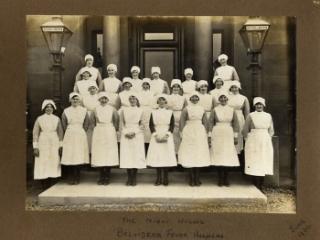
‘Have you done the extra work today?’
‘I have done everything. I have not sat down’
‘You mean to tell me you do not know what the extra work means! Come with me. You are the junior probationer and these things have to be done by you every day’.
No one had told me, but she said that I should start at once. It was Sunday and I remembered that they also went to the Kirk and I flew to this thing. I had to clean the light shades, high up overhead. Where were the steps?
‘For goodness sake girl, have you no imagination. You don’t need steps. . You see that table, you take a chair and you put it on the table and you stand on that and you will reach the light.’
Another nursing duty was to scrub all the drawers. You had to empty them, scrub them out and dry them. We also had to clean all the brass knobs and things with some of the beds. And the Fire pail full of water had to be changed by the Night staff. Sister inspected it every morning, checking for dust on the surface – a sure sign of failure.
There were about 8 wards for those with Lobar pneumonia and no treatment other than cough medicine. The junior probationer had to go round and empty the sputum cups three times a day and the night nurses once. You took them on the tray into the slunge room, emptied and cleaned them. There were no gloves and it was probably the worst thing I had to do.
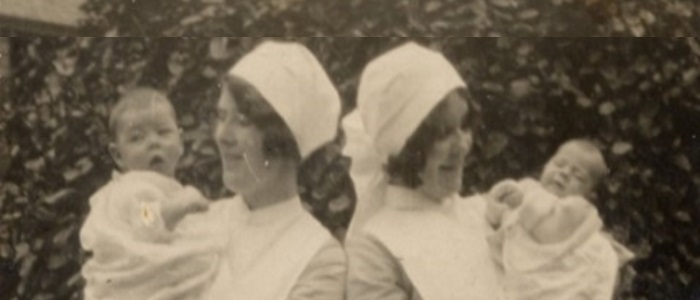
There were 8 diphtheria wards. One wee kiddy used to sing
‘When I was single I used to hae a shawl, but noo that I am mairrit I havnae one at all,
Oh it’s a life, a weary weary life, it’s better to be single than to be a mairrit wife’ (Glasgow Street Song).
Whenever I hear that play it takes me to that ward in Belvidere.
These were infectious diseases wards and there was a big place at the Gate where the visitors came in. It had a great big main hall and a Balcony. The Sister for each of the wards went onto the Balcony. There would be a queue of people for each ward.
‘What is your child’s name?’
‘Mary Jane-how is she tonight?’
‘Not too bad. Have you got her anything?’
‘I have brought her some apples’
And you handed up to the Ward Sister what you had brought for the child. Now these were poverty stricken people and it would cost them just to bring in a bar of chocolate - but they did it. They handed the things up to Sister who put them in a basket and took them to the Ward.
They were poor souls. They never saw their relatives unless they were going to die.
The Mortuary had a big room where you could see where they put the patients. You were not allowed to go in but the Night nurse in Ward 2 had to clean the Chapel every night. She had to clean the window looking into the big room and very often there would be a wee baby lying in there. It was dreadful and so sad.
The food in Belvidere was absolutely dreadful. I remember one wee boy in the Scarlet fever ward. These boys were put in there for convalescence and they were all starving hungry and they got boiled eggs for their breakfast. The Night nurse had to make the breakfast, boil up the eggs. Then this wee boy was terribly sick. His egg was rotten, the others said.
‘Well, I was that hungry and I just knew that if I said to you I wouldn’t get another one and I was that hungry I just ate it.
My Mother spent three years in Belvidere. As she progressed and got to the senior stage she felt better and knew what she was doing.
‘When I came to leave Belvidere I was senior and I was a Staff Nurse in the pneumonia ward. I knew my stuff by that time and I could walk down that ward and look at people and tell how they were progressing. They all had a ‘crises’ and I was at the stage where I could tell by looking at people when they were lying in bed - we were taught observation.'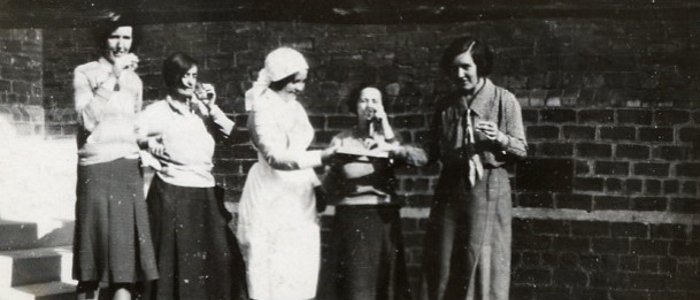
She finally qualified as a State Registered Nurse in Glasgow Royal Infirmary in 1936, did Midwifery and became a Sister Tutor. She was married on September 4th 1939 , resigned from Nursing and became my Mother. Married ladies could not remain in the Nursing Profession in 1939, but she was welcomed back in 1963 to become Sister Tutor at Strathclyde Hospital.
Some recollections by Dr Harry Gray
Dr Harry Gray is a retired physician from the University Medical Unit, Glasgow Royal Infirmary and was primarily a physician in Internal Medicine and Nuclear Medicine.
Read more in his blog
A fourth year student's recollections
A fourth year student’s experience as a student and a locum in Surgery
In my first clinical term in surgery, I was assigned to Mr Beattie’s unit at Glasgow Royal Infirmary, along with 10 others. The group had just finished an evening teaching ward round with Mr Beattie himself between 6.30 pm and 7.30 pm. We finished earlier than expected and to our surprise, Mr Beattie took us into the students’ room and began asking us about our experience of the medical course so far. After some general discussion, he asked us if we had any questions for him. I knew this man a bit because my father, who had been a general practitioner in East Kilbride, had often brought Mr Beattie out to see one of his patients and then brought him back to our house where I had met him as a boy.
I asked him what the most important and influential thing he had seen in his long (and distinguished) career in surgery. In fact, it had been nothing surgical at all. He told us that in 1942, he was the receiving doctor on call at the Royal Infirmary and admitted a young man with meningococcal meningitis and septicaemia. In 1942, this diagnosis was a death sentence. He performed the lumbar puncture to confirm the diagnosis and withdrew the purulent cerebrospinal fluid (CSF). Just as he was about to remove the lumbar puncture needle, he recalled that he had been given instructions that if anyone came in with this diagnosis, he was to inject into the CSF, a vial of ‘stuff coloured purple’ which was in the ward fridge. This he did, removed the needle and was called away fully expecting that the young man would be dead in the morning. Arriving at the ward next morning, he was amazed to see the previously septic man sitting up and eating his breakfast. Mr Beattie asked us what we thought was in the vial of ‘purple stuff’. No one answered. He then told us that he had been the first doctor at the Royal Infirmary to administer unrefined penicillin. He remembered that the young man was required to collect all his urine for 48 hours. The urine had to be sent down to London for removal of the excreted penicillin for use again.
Student locums (for house officers) were common practice at the time, though normally involved students in their final years whose knowledge base was greater. The surgical resident spoke to the group of students just before we left one morning and asked whether any of us would be interested in covering for him for a few days at the year’s end. I had spent a few Saturday evenings in the Casualty department, and wondered whether that would give me enough experience for the task. So I volunteered and duly appeared on the evening of the 26th December and settled into the resident’s bedroom close to the lifts. To my great relief, the other resident surgeon took over both the two other wards on the floor and was very helpful particularly when drug prescriptions were required.
Within hours however, my overriding realisation was that I was a novice and had been thrown in at the deep end. I had to rapidly learn how to take venous blood using the old sterilisable glass syringes, though fortunately, we had started to use disposable needles. Unfortunately, the glass syringe plungers were too easy to pull and if you pulled the plunger all the way, the result was a bed soaked in blood and a very cross ward sister. Intravenous lines in those days were setup using Braunula cannulae. These were fearsome beasts and were not only much larger than used today, but had a plastic shoulder at the tip that could be difficult and painful to push through the skin. One other real frustration was the request for Blood Urea & Electrolytes. I had to inject venous blood under clear oil contained in a largish glass bottle. Fortunately, there were few blood tests available and so the blood round did not take long in the morning.
I quickly learned to take notes during ward rounds for use when writing histories on the requests for blood tests or radiological examinations. I was not expected to deal with emergency admissions on the one receiving day during the locum period. The nursing staff were very helpful, because they realised that I was completely out of my depth and took pity on me.
One occasion is burned into my memory. I was asked, by the consultant, who was also supportive, to catheterize a man with a chronic urinary retention. It was clear to the nursing staff that I had no idea what was being asked of me. The senior nurse took pity on me and took me through the procedure. I was shown how to gown, mask and glove up and use the packs in a sterile way. She assisted so I did not panic. I was, however, appalled to learn that I had to stick some anaesthetic up the patient’s urethra and then a sizeable catheter. It was a surreal moment for a naïve 19 year old but highlighted that I had missed the first step of the prevailing maxim of the time: “see one, do one, teach one”.
I learned much during the 5 days. Despite the bravado of a male surgical ward in the East End of Glasgow, patients were anxious, and required human contact that was calm and sympathetic. The men in the ward were perceptive, rapidly deducing that I was a novice, and supported my efforts. I could not have continued without the support from all the nursing staff. Finally, I learned that I knew nothing, so that made me determined to improve, and gave me the confidence to tackle locums later on in 5th and 6th year.
I was glad when the house officer returned from his holiday. I returned home secure in the knowledge that my forthcoming sleep would be undisturbed.
Recollections on the University Medical Unit
A Junior House Officer on the University Medical Unit Glasgow Royal Infirmary in 1965
My first experience of the University Medical Unit (UMU) at Glasgow Royal Infirmary was as a student in 1963. Professor Edward McGirr taught us personally once a week on a patient in bed, who would be wheeled into the ‘lecture room’ on ward 3 and we would sit round the bed on chairs. I did well in the end-of-term exam so was invited to be one of his resident Junior House Officers (JHOs) in 1965, paid £40 per month plus full board and lodging. The 4 of us including Dr Bob Lindsay, Dr Marjory Allison and Dr Carol Browne gathered at 9 am in the coffee room off ward 3 and were greeted by a senior member of staff in charge of the wards who outlined our duties and responsibilities. We would be on-call 24/7 for our wards with acute receiving every Friday, and every 5th Friday/Saturday and Friday/Sunday for 48 hours at a stretch. We each lived in one of the residents’ rooms.
After 2 weeks of on-call every night for ward 3, I tentatively proffered a suggestion to the Senior Lecturer who had given us our welcome to the Unit, that each resident in wards 2 and 3 might cover both wards on alternate nights, but we would sleep in our rooms as usual in case there were problems that required our prior knowledge. He dismissed my suggestion out-of-hand. Some days later, after a ward round, I was having a coffee with Professor McGirr and others in the staff room and, when asked directly about our thoughts on the Unit, I told him of my suggestion. He thought it was a great idea and told me to organise it. The Senior Lecturer was not pleased, but at least I got some sleep alternate nights.
Receiving was problematical for us because the JHO’s were in the Casualty Department in the gatehouse in 4 hour stretches over the 24 hours, with help when required from the two Senior House Officers (SHOs). It was made more difficult by closure of the haematology, bacteriology and biochemistry laboratories after 5 pm until 8 am next morning. The JHO’s therefore had to personally measure the blood Packed Cell Volume (PCV), Haemoglobin, and Erythrocyte Sedimentation Rate; and perform blood film, urinalysis and urine microscopy on each patient admitted. It was best to batch them and this task usually was completed well after midnight. It was worse if one admitted an out-of-hours diabetic because we then personally had to measure the blood glucose by the Folin-Wu method. This involved preparing 7 known concentrations of glucose in 7 tubes with the serum from the patient in the 8th tube and a 9th blank. A known concentration of blue indicator (copper sulphate I recall) was then added to each tube and the serum concentration approximated by comparison with one of the known tubes - one hoped. It was very time consuming preparing all the tubes but thankfully, in those days, we rarely saw diabetic ketoacidosis at night. If your last admission to the ward was just after 12 midnight, it was about 3.30am before you saw a bed because of all these pesky tests. One could not miss them out, however, because although the results were written in the case notes, some of the consultants would want to examine the blood film and PCV tube themselves.
The Friday and Saturday 48 hour receiving was a trial because there was no hiding place. You were on all the time and were up and down to Casualty both days every 4 hours at a time, sharing with your co-resident and grabbing as much sleep as you could whenever you were able. The SHO covered the ward thankfully when you were down there, but only wrote up their pink sheet summary, not the JHO summary, which was always looked at so had to be written up afterwards. The SHOs also came down to Casualty when the workload became too great or there were diagnostic problems. I remember one time after 36 hours of receiving, I was very tired and a patient with a haematemesis was admitted. I was taking a history by the bedside and he was describing his vomit when I suddenly felt sick and lightheaded and had to be sent to lie down for 2 hours. I was OK after that and continued with the receiving duties.
The JHOs relied heavily upon the nursing staff because of their own lack of experience. The ward Sister in ward 3 was kind and considerate and the staff superb. It was a Nightingale ward design with 24 beds usually arranged along the sides of the ward with the toilets at the end of the ward in the ‘sluice’, a projection out from the ward proper. There was only a one bedded side room at that time so when we were busy, extra beds were accommodated by lining them up in the middle of the ward as well, top to tail. We had our own Unit orderly called Jimmy Murphy who helped to keep the test rooms clean and tidy among his many other duties. The nurses helped to distribute the meals that were made on-site at GRI and were quite acceptable in those days. Ward 3 and 2 each had their own cleaner who kept the ward and toilets spotless. Jimmy ensured that our white coats, that had been measured to fit perfectly and had our names and ward imprinted on them, were always ready on Monday morning for us hanging on our lockers.
The JHOs had full board and a doctor’s mess on the ground floor situated underneath the medical block and contiguous with the Board Room. After eating in the canteen, we could move to the next room where there were armchairs, a table tennis table and a TV for those with time on their hands while on-call.
The JHO’s were present at each ward round 6 days a week, took all of the bloods at all times and did their own rounds on Sunday. We spent 3 months in wards 2 and 3, then 6 weeks in each of the new Baird Street rheumatology hospital, and ward A3 at the Eastern District Hospital in Duke Street Hospital. Here, the residents stayed in good accommodation, with no receiving duties and therefore sleep was more readily available. Unless you slept heavily, you were wakened each morning at 6 am by the distressed bellowing of the cows about to be slaughtered in the abattoir across the road.
A conversation with Stuart McAlpine
Stuart McAlpine, a graduate of the University of Glasgow in 1949, discusses his career including his time as as a Senior House Officer in the University Department of Medicine, Royal Infirmary, 1952-1957.
Stewart McAlpine, in conversation with Harry Gray
Medicine
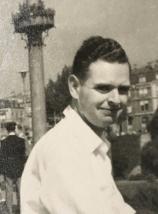
I graduated in Medicine in Glasgow in 1949 and was a resident house physician with Professor JW McNee in the Western Infirmary. After my residencies I did national service in the Royal Army Medical Corps in the Middle East, and was medical officer to the Queen’s Own Cameron Highlanders. I wrote to Prof McNee and asked if there was any prospect of a Senior House Officer (SHO) job in his department. He replied that there wasn’t, but he had spoken to Professor Leslie J Davis in the Royal Infirmary, who would like to see me when I came back. At the interview it was arranged that I start on the 1st of August. Davis, a keen sailor, had a lovely yacht on the Clyde, and he would disappear after the final examinations in June and reappear in September. So he wasn’t there when I started as an SHO on 1st August.
Davis was the Chief, and the chiefs were chiefs in those days. For example, all the letters that went out had to be on behalf of Prof L J Davis. His interest was Haematology, and he established a Blood Clinic on the wards, and Laboratory in the Department’s St Mungo building. His number two was Alex Brown (with whom he published a book on the Megaloblastic Anaemias), who did female ward rounds on Ward 2; and his number three was an NHS Chest Physician, Tom McEwan who did male ward rounds on Ward 3. The lecturer (to the Dental students) was Edward McGirr, who was developing thyroid and nuclear medicine, and did ward rounds in the nearby Duke Street Hospital. Mary Smith was a senior registrar who did the blood clinic with me. Stuart Douglas, a registrar, had gone to Oxford Haemophilia Centre as an MRC Fellow. Arthur Kennedy was another registrar and went to Dumfries as senior registrar. Other SHOs/Hall Fellows were Robert Pirie and Albert Baikie, with whom I did receiving duties.
There were five medical units on separate floors of the Infirmary and we received every Monday, and one weekend in five when we had our outpatient clinic on the Saturday morning. Receiving was not busy in those days. If we got 8 or 9 admitted, then that was busy.
All the University staff were full time. The NHS consultants were on 7/11 sessions and so they disappeared around 11.30 am after the ward rounds as the rest of their salaries were made up from private practice. Later, this changed to 9/11.
I did the blood clinic on the wards, where a technician at the end of the corridor prepared blood films on all the patients and we examined all the films after the clinic. I also performed 400 bone marrow aspirations in a year, mainly sternal but occasional iliac crest. Stuart Douglas also showed me how to do a liver biopsy – I saw one, did one, then I taught one. After a year or so, Davis asked me “What do you see at the blood clinic?” I said, “Well there are the usual pale people sent up by their GPs, but we get a surprising number of people with spleens and livers for diagnosis.” “Oh that is interesting” he said. “I think you better do an MD on that.” So I smiled and shrugged and carried on. Three months later he asked how my MD was getting on. I thought about it, gathered 100 cases of these problems, and this formed the basis for my MD which they gave me with commendation. This was before Sheila Sherlock’s book on liver diseases was published. Davis was very put out when she published it and told me, “You should have published more of that, McAlpine”.
In 1954 I got my Fellowship of the Royal Faculty of Physicians and Surgeons of Glasgow, which was the precursor of the Membership of the Royal Colleges of Physicians of the UK. I was the only candidate out of 25 who passed.
During the 1956 Suez crisis, petrol was rationed in the UK. I lived near to Prof Davis in the West End of Glasgow so he asked if I would pick him up in the morning because he needed his petrol ration to drive down to his yacht at weekends. I would quite often take him home at night, and got to know him better. We both smoked a pipe, and sometimes when his tobacco pouch was empty he would say “Have you any tobacco, McAlpine” and I would give him my pouch to fill his pipe. One morning in the car he told me that Stuart Douglas was coming back from Oxford and said “Do you know how I came to appoint Dr Douglas? Well there were three good candidates, but one I was not keen on; and another was a fellow you couldn’t have a drink with so I wasn’t going to take him either.” Then he turns to me and says “Never you appoint anyone that you can’t have a drink with”.
In 1957 I went to Dumfries as a registrar, following Arthur Kennedy. I received my MD degree and my Membership of the Royal College of Physicians of London, and returned as a senior registrar to Glasgow Royal Infirmary, under Dr Joseph Wright on the 3rd floor, training as a cardiologist 1957-1963. Like Professor Davis, Joe Wright was “the boss”. He didn’t drive, so (as I did for Prof Davis during the Suez crisis) I became his chauffeur. I found I was working seven days a week. I had to pick him up, take him to GRI, and bring him home sometimes too. I also had to take him to see his private patients in Canniesburn Hospital. This was every single day, even on Sundays. Dr Wright also did domiciliary visits on Sunday mornings. I would sometimes take him to Girvan or to Lanark or even Helensburgh. Really, we went all over the place. I remember getting £5 for this on Sundays. On one occasion, by mistake, he gave me a £20 note. I looked at it and told him so he hastily took it back.
In 1963 I was appointed consultant physician with Hugh Conway in the Royal Alexandra Infirmary, Paisley.
Dr June Almeida Pioneer of Virus Imaging
A story for today, an unsung hero
Dr June Almeida, born June Hart in 1930 was brought up in Dennistoun. Her first job was in Glasgow Royal Infirmary as a lab technician in Histopathology. She then worked in London, married and emigrated to Canada and developed her skills in electronmicroscopy.
She and her family returned to London, to St Thomas's Hospital. There along with other researchers, she discovered and named the first coronavirus, a virus which seemed to have a halo or crown around it. Find out more..


